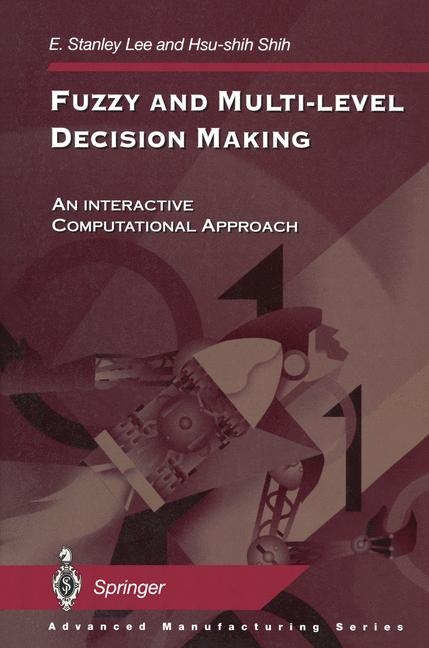
Fuzzy and Multi-level Decision Making
Springer London Ltd (Verlag)
978-1-85233-157-3 (ISBN)
- Titel ist leider vergriffen;
keine Neuauflage - Artikel merken
1. Introduction.- 1.1 Decision Making in Hierarchy Systems: Multi-ploy versus Interactive Decisions.- 1.2 Bi-Level and Multi-level Programming.- 1.3 Characteristics of Duo-ploy Systems.- 1.4 Characteristics of Duo-ploy Systems with Multi-followers.- 1.5 Fuzzy Interactive Decision Making.- 2. Linear Bi-level Programming.- 2.1 Linear Bi-level Programming.- 2.2 Extreme-point Search.- 2.2.1 kth-best Algorithm.- 2.2.2 Grid-search Algorithm.- 2.3 Transformation Approach.- 2.3.1 Mixed-integer Approach.- 2.3.2 Complementary-pivot algorithm.- 2.3.2.1 Parametric Complementary-pivot Algorithm.- 2.3.2.2 Sequential Linear Complementary Algorithm with Branch-and-bound.- 2.3.3 Branch-and-bound Algorithm.- 2.3.3.1 Algorithm of Bard and Moore.- 2.3.3.2 Algorithm of Hansen et al.- 2.3.4 Penalty-function Approach.- 2.4 Discussions.- 3. Other Multi-level Programming Algorithms.- 3.1 Linear Bi-level Distributed Programming.- 3.1.1 Mixed-integer Problem with Complementary Slackness.- 3.1.2 Penalty-function Approach.- 3.2 Linear Three-level Programming Problem.- 3.2.1 Hybrid Extreme-point Search Algorithm.- 3.2.2 Mixed-integer Problem with Complementary Slackness.- 3.2.3 Simplex-cutting-plane Algorithm.- 3.2.4 Penalty-function Approach.- 3.3 Non-linear Multi-level Programming.- 3.3.1 Sequential Linear-quadratic Complementary Algorithm with Branch-and-bound.- 3.3.2 Steepest-descent Approach.- 3.3.3 Evolutionary Approach: Genetic Algorithms.- 3.4 Discrete Bi-level Programming.- 3.5 Discussions.- 4. Possibility Theory and Knowledge Representation.- 4.1 Possibility Theory.- 4.1.1 Possibility Distribution.- 4.1.2 Possibility Measure.- 4.1.3 Possibility Measure Based on Fuzzy Set with Fuzzy Subset.- 4.1.4 Possibility versus Probability.- 4.2 Knowledge Representation.- 4.2.1 Linguistic Variable.- 4.2.2 The Syntactic Rule.- 4.2.3 The Semantic Rule.- 4.2.4 Test-score Semantics.- 5. Fuzzy Decision Making.- 5.1 Fuzzy Linear Programming.- 5.2 Multiple-objective Programming.- 5.2.1 Compromise Programming.- 5.2.2 Goal Programming.- 5.3 Fuzzy Approach to Multiple-objective Programming.- 5.4 Fuzzy Multiple-objective Programming with Fuzzy Parameters.- 5.5 Possibility Programming.- 5.5.1 Possibility Linear Programming.- 5.5.2 Multiple-objective Possibility Programming.- 6. Fuzzy Interactive Multi-level Decision Making.- 6.1 Fuzzy Bi-level Interactive Decision Making.- 6.2 Fuzzy Bi-level Interactive Decision Making with Multi-followers.- 6.3 Fuzzy Multi-level Interactive Decision Making.- 6.4 Fuzzy Multi-level Interactive Decision Making with Multi-followers.- 6.5 Discussions.- 7. Aggregation of Fuzzy Systems in Multi-level Decisions.- 7.1 Compensation in Bi-level Decisions.- 7.2Compensation in Multiple-level Problems.- 7.3 Bi-level Decentralized Problem with Equally Important Objectives.- 7.4 Bi-level Decentralized Problem with Unequally Important Objectives.- 7.5 Multiple-level Decentralized Problem.- 7.6 Fuzzy Multi-level Problem.- 7.7 Discussions.- 8. Possibilistic Minimum-cost Flow Problem.- 8.1 Minimum-cost Flow Problem.- 8.2 Possibility Approach to Minimum-cost Flow Problem.- 8.2.1 Capacity Constraint Modification.- 8.2.2 Possibility Programming.- 8.3 Possibility Approach to Multi-objective Minimum-cost Flow Problem.- 8.4 Possibility Approach to Multi-level Minimum-cost Flow Problem.- 8.5 Discussions.- References.
| Reihe/Serie | Advanced Manufacturing |
|---|---|
| Zusatzinfo | biography |
| Verlagsort | England |
| Sprache | englisch |
| Gewicht | 460 g |
| Einbandart | gebunden |
| Themenwelt | Mathematik / Informatik ► Mathematik ► Angewandte Mathematik |
| Technik ► Maschinenbau | |
| ISBN-10 | 1-85233-157-7 / 1852331577 |
| ISBN-13 | 978-1-85233-157-3 / 9781852331573 |
| Zustand | Neuware |
| Haben Sie eine Frage zum Produkt? |
aus dem Bereich


